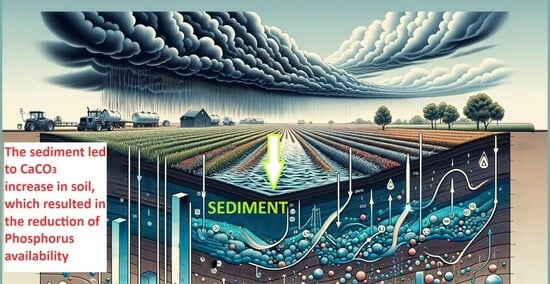Analyzing the Impact of Storm ‘Daniel’ and Subsequent Flooding on Thessaly’s Soil Chemistry through Causal Inference
Abstract
1. Introduction
2. Materials and Methods
2.1. Soil Sampling and Analysis
2.2. Data Preprocessing
2.3. Machine Learning
2.4. SHAP Analysis
2.5. Casual Representation, Discovery, and Reasoning
3. Results
3.1. Causal Inference
3.2. Machine Learning and SHAP Analysis
3.3. Crop Phosphorus Fertilizer Rate for Soils with Sediments
4. Discussion
5. Conclusions
Author Contributions
Funding
Institutional Review Board Statement
Data Availability Statement
Conflicts of Interest
References
- European Academies Science Advisory Council. Extreme Weather Events in Europe Preparing for Climate Change Adaptation: An Update on EASAC’s 2013 Study. Available online: https://easac.eu/publications/details/extreme-weather-events-in-europe (accessed on 15 January 2024).
- Furtak, K.; Wolińska, A. The Impact of Extreme Weather Events as a Consequence of Climate Change on the Soil Moisture and on the Quality of the Soil Environment and Agriculture—A Review. Catena 2023, 231, 107378. [Google Scholar] [CrossRef]
- Loeb, R.; Lamers, L.P.M.; Roelofs, J.G.M. Effects of Winter versus Summer Flooding and Subsequent Desiccation on Soil Chemistry in a Riverine Hay Meadow. Geoderma 2008, 145, 84–90. [Google Scholar] [CrossRef]
- Christensen, J.H.; Christensen, O.B. Severe Summertime Flooding in Europe. Nature 2003, 421, 805–806. [Google Scholar] [CrossRef] [PubMed]
- Khatibi, E.; Abbasian, M.; Azimi, I.; Labbaf, S.; Feli, M.; Borelli, J.; Dutt, N.; Rahmani, A.M. Impact of COVID-19 Pandemic on Sleep Including HRV and Physical Activity as Mediators: A Causal ML Approach. In Proceedings of the 2023 IEEE 19th International Conference on Body Sensor Networks (BSN), Cambridge, MA, USA, 9–11 October 2023; pp. 1–4. [Google Scholar]
- Sanchez, P.; Voisey, J.P.; Xia, T.; Watson, H.I.; O’Neil, A.Q.; Tsaftaris, S.A. Causal Machine Learning for Healthcare and Precision Medicine. R. Soc. Open Sci. 2022, 9, 220638. [Google Scholar] [CrossRef]
- Karydas, C.; Iatrou, M.; Kouretas, D.; Patouna, A.; Iatrou, G.; Lazos, N.; Gewehr, S.; Tseni, X.; Tekos, F.; Zartaloudis, Z.; et al. Prediction of Antioxidant Activity of Cherry Fruits from UAS Multispectral Imagery Using Machine Learning. Antioxidants 2020, 9, 156. [Google Scholar] [CrossRef] [PubMed]
- Iatrou, M.; Karydas, C.; Iatrou, G.; Pitsiorlas, I.; Aschonitis, V.; Raptis, I.; Mpetas, S.; Kravvas, K.; Mourelatos, S. Topdressing Nitrogen Demand Prediction in Rice Crop Using Machine Learning Systems. Agriculture 2021, 11, 312. [Google Scholar] [CrossRef]
- Fehr, J.; Piccininni, M.; Kurth, T.; Konigorski, S. Assessing the Transportability of Clinical Prediction Models for Cognitive Impairment Using Causal Models. BMC Med. Res. Methodol. 2023, 23, 187. [Google Scholar] [CrossRef] [PubMed]
- Shimizu, S.; Inazumi, T.; Kawahara, Y.; Washio, T.; Hoyer Patrikhoyer, P.O.; Bollen, K.; Sogawa, Y.; Hyvärinen, A.; Hoyer, P.O.; Bollen Shimizu, K. DirectLiNGAM: A Direct Method for Learning a Linear Non-Gaussian Structural Equation Model Yasuhiro Sogawa Aapo Hyvärinen. J. Mach. Learn. Res. 2011, 12, 1225–1248. [Google Scholar]
- Prendin, F.; Pavan, J.; Cappon, G.; Del Favero, S.; Sparacino, G.; Facchinetti, A. The Importance of Interpreting Machine Learning Models for Blood Glucose Prediction in Diabetes: An Analysis Using SHAP. Sci. Rep. 2023, 13, 16865. [Google Scholar] [CrossRef] [PubMed]
- Lundberg, S.M.; Lee, S.-I. A Unified Approach to Interpreting Model Predictions. arXiv 2017, arXiv:1705.07874. [Google Scholar]
- Wojtuch, A.; Jankowski, R.; Podlewska, S. How Can SHAP Values Help to Shape Metabolic Stability of Chemical Compounds? J. Cheminform. 2021, 13, 74. [Google Scholar] [CrossRef] [PubMed]
- Lloyd, S. N-Person Games. Def. Tech. Inf. Cent. 1952, 295–314. [Google Scholar] [CrossRef]
- Gramegna, A.; Giudici, P. SHAP and LIME: An Evaluation of Discriminative Power in Credit Risk. Front. Artif. Intell. 2021, 4, 752558. [Google Scholar] [CrossRef] [PubMed]
- Niyogi, D.; Kishtawal, C.; Tripathi, S.; Govindaraju, R.S. Observational Evidence That Agricultural Intensification and Land Use Change May Be Reducing the Indian Summer Monsoon Rainfall. Water Resour. Res. 2010, 46, 1–17. [Google Scholar] [CrossRef]
- Copernicus Emergency Management Service Directorate Space, Security and Migration, European Commission Joint Research Centre (EC JRC). Available online: https://emergency.copernicus.eu/ (accessed on 25 November 2023).
- Miller, J.; Curtin, D. Electrical Conductivity and Soluble Ions. 2007. Available online: https://www.researchgate.net/publication/288518660_Electrical_Conductivity_and_Soluble_Ions (accessed on 19 December 2023).
- Gavlak, R.G.; Horneck, D.A.; Miller, R.O. Plant, Soil, and Water Reference Methods for the Western Region; Western Rural Development Center: Logan, UT, USA, 1994. [Google Scholar]
- Pearson, D. The Chemical Analysis of Foods, 7th ed.; Churchill Livingstone: London, UK, 1976. [Google Scholar]
- Walkley, A.; Black, I.A. An examination of the degtjareff method for determining soil organic matter, and a proposed modification of the chromic acid titration method. Soil Sci. 1934, 37, 29–38. [Google Scholar] [CrossRef]
- Van Reeuwijk, L.P. Procedures for Soil Analysis. 2002. Available online: https://www.isric.org/sites/default/files/ISRIC_TechPap09.pdf (accessed on 23 November 2023).
- Bouyoucos, G.J. Hydrometer Method Improved for Making Particle Size Analyses of Soils. Agron. J. 1962, 54, 464–465. [Google Scholar] [CrossRef]
- Iatrou, M.; Papadopoulos, A.; Papadopoulos, F.; Dichala, O.; Psoma, P.; Bountla, A. Determination of Soil Available Phosphorus Using the Olsen and Mehlich 3 Methods for Greek Soils Having Variable Amounts of Calcium Carbonate. Commun. Soil Sci. Plant Anal. 2014, 45, 2207–2214. [Google Scholar] [CrossRef]
- Knudsen, D.; Peterson, G.A.; Pratt, P.F. Lithium, Sodium, and Potassium. In Methods of Soil Analysis; Agronomy Monographs; Wiley: Hoboken, NJ, USA, 1983; pp. 225–246. ISBN 9780891189770. [Google Scholar]
- Iatrou, M.; Papadopoulos, A.; Papadopoulos, F.; Dichala, O.; Psoma, P.; Bountla, A. Determination of Soil-Available Micronutrients Using the DTPA and Mehlich 3 Methods for Greek Soils Having Variable Amounts of Calcium Carbonate. Commun. Soil Sci. Plant Anal. 2015, 46, 1905–1912. [Google Scholar] [CrossRef]
- Breiman, L. Random Forests. Mach. Learn. 2001, 45, 5–32. [Google Scholar] [CrossRef]
- Howard, J.; Gugger, S. Deep Learning for Coders with Fastai and PyTorch; O’Reilly Media: Sebastopol, ON, Canada, 2020. [Google Scholar]
- Howard, J.; Gugger, S. Fastai: A Layered API for Deep Learning. arXiv 2020, arXiv:2002.04688. [Google Scholar] [CrossRef]
- Ke, G.; Meng, Q.; Finley, T.; Wang, T.; Chen, W.; Ma, W.; Ye, Q.; Liu, T.-Y. LightGBM: A Highly Efficient Gradient Boosting Decision Tree. In Proceedings of the Advances in Neural Information Processing Systems; Guyon, I., Von Luxburg, U., Bengio, S., Wallach, H., Fergus, R., Vishwanathan, S., Garnett, R., Eds.; Curran Associates, Inc.: Red Hook, NY, USA, 2017; Volume 30. [Google Scholar]
- Iatrou, M.; Karydas, C.; Tseni, X.; Mourelatos, S. Representation Learning with a Variational Autoencoder for Predicting Nitrogen Requirement in Rice. Remote Sens. 2022, 14, 5978. [Google Scholar] [CrossRef]
- Chen, T.; Guestrin, C. XGBoost: A Scalable Tree Boosting System. In Proceedings of the 22nd ACM SIGKDD International Conference on Knowledge Discovery and Data Mining, San Francisco, CA, USA, 13–17 August 2016; ACM: New York, NY, USA, 2016; pp. 785–794. [Google Scholar]
- Akiba, T.; Sano, S.; Yanase, T.; Ohta, T.; Koyama, M. Optuna: A Next-Generation Hyperparameter Optimization Framework. arXiv 2019, arXiv:1907.10902. [Google Scholar]
- Madhushani, C.; Dananjaya, K.; Ekanayake, I.U.; Meddage, D.P.P.; Kantamaneni, K.; Rathnayake, U. Modeling Streamflow in Non-Gauged Watersheds with Sparse Data Considering Physiographic, Dynamic Climate, and Anthropogenic Factors Using Explainable Soft Computing Techniques. J. Hydrol. 2024, 631, 130846. [Google Scholar] [CrossRef]
- Joseph, A. Shapley Regressions: A Framework for Statistical Inference on Machine Learning Models, 4th ed.; Bank of England and King’s College London: London, UK, 2019. [Google Scholar]
- Howard, R.; Kunze, L. Evaluating Temporal Observation-Based Causal Discovery Techniques Applied to Road Driver Behaviour. arXiv 2023, arXiv:2302.00064. [Google Scholar]
- Pearl, J. Causal Diagrams for Empirical Research. Biometrika 1995, 82, 669–688. [Google Scholar] [CrossRef]
- Hyvärinen, A.; Smith, S.M.; Spirtes, P. Pairwise Likelihood Ratios for Estimation of Non-Gaussian Structural Equation Models. J. Mach. Learn. Res. 2013, 14, 111–152. [Google Scholar] [PubMed]
- Hoyer, P.O.; Janzing, D.; Mooij, J.; Peters, J.; Schölkopf, B. Nonlinear Causal Discovery with Additive Noise Models. In Proceedings of the 21st International Conference on Neural Information Processing Systems, Kuching, Malaysia, 3–6 November 2014; Curran Associates Inc.: Red Hook, NY, USA, 2014; pp. 689–696. [Google Scholar]
- Peters, J.; Mooij, J.M.; Janzing, D.; Schölkopf, B. Causal Discovery with Continuous Additive Noise Models. arXiv 2014, arXiv:1309.6779. [Google Scholar]
- Strobl, E.V.; Lasko, T.A. Identifying Patient-Specific Root Causes with the Heteroscedastic Noise Model. J. Comput. Sci. 2023, 72, 102099. [Google Scholar] [CrossRef]
- Komatsu, Y.; Shimizu, S.; Shimodaira, H. Assessing Statistical Reliability of LiNGAM via Multiscale Bootstrap. In Proceedings of the 20th International Conference on Artificial Neural Networks: Part III, Thessaloniki Greece, 15–18 September 2010; Springer: Berlin/Heidelberg, Germany, 2010; pp. 309–314. [Google Scholar]
- Brownlee, J. Deep Learning with Python. Develop Deep Learning Models on Theano and Tensorf Flow Using Keras. Machine Learning Mastery. 2018. Available online: https://bayanbox.ir/view/269467307605579794/deep-learning-with-python.pdf (accessed on 20 December 2023).
- Brownlee, J. Better Deep Learning. Train Faster, Reduce Overfitting, and Make Better Predictions; Machine Learning Mastery: San Juan, Puerto Rico, 2019. [Google Scholar]
- Van Rossum, G.; Drake, F.L. Python Tutorial. History 2010, 42, 270–272. [Google Scholar] [CrossRef]
- Hunter, J.D. Matplotlib: A 2D Graphics Environment. Comput. Sci. Eng. 2007, 9, 90–95. [Google Scholar] [CrossRef]
- Waskom, M.; Botvinnik, O.; O’Kane, D.; Hobson, P.; Lukauskas, S.; Gemperline, D.C.; Augspurger, T.; Halchenko, Y.; Cole, J.B.; Warmenhoven, J.; et al. Mwaskom/Seaborn: V0.8.1 (September 2017). 2017. Available online: https://zenodo.org/records/883859 (accessed on 14 November 2023). [CrossRef]
- Cakiroglu, C.; Demir, S.; Hakan Ozdemir, M.; Latif Aylak, B.; Sariisik, G.; Abualigah, L. Data-Driven Interpretable Ensemble Learning Methods for the Prediction of Wind Turbine Power Incorporating SHAP Analysis. Expert Syst. Appl. 2024, 237, 121464. [Google Scholar] [CrossRef]
- Papadopoulos, A.; Papadopoulos, F.; Tziachris, P.; Metaxa, I.; Iatrou, M. Site Specific Management with the Use of a Digitized Soil Map for the Regional Unit of Kastoria. Ecosyst. Nat. Resour. Manag. 2014, 16, 59–67. [Google Scholar]
- Kruskal, W.H.; Wallis, W.A. Use of Ranks in One-Criterion Variance Analysis. J. Am. Stat. Assoc. 1952, 47, 583–621. [Google Scholar] [CrossRef]
- Malhotra, H.; Vandana; Sharma, S.; Pandey, R. Phosphorus Nutrition: Plant Growth in Response to Deficiency and Excess. In Plant Nutrients and Abiotic Stress Tolerance; Hasanuzzaman, M., Fujita, M., Oku, H., Nahar, K., Hawrylak-Nowak, B., Eds.; Springer: Singapore, 2018; pp. 171–190. ISBN 978-981-10-9044-8. [Google Scholar]
- Biswas Chowdhury, R.; Zhang, X. Phosphorus Use Efficiency in Agricultural Systems: A Comprehensive Assessment through the Review of National Scale Substance Flow Analyses. Ecol. Indic. 2021, 121, 107172. [Google Scholar] [CrossRef]
- Loeppert, R.H. Reactions of Iron and Carbonates in Calcareous Soils. J. Plant Nutr. 1986, 9, 195–214. [Google Scholar] [CrossRef]
- Shah, A.; Shah, S.; Shah, V. Impact of Flooding on the Soil Microbiota. Environ. Chall. 2021, 4, 100134. [Google Scholar] [CrossRef]
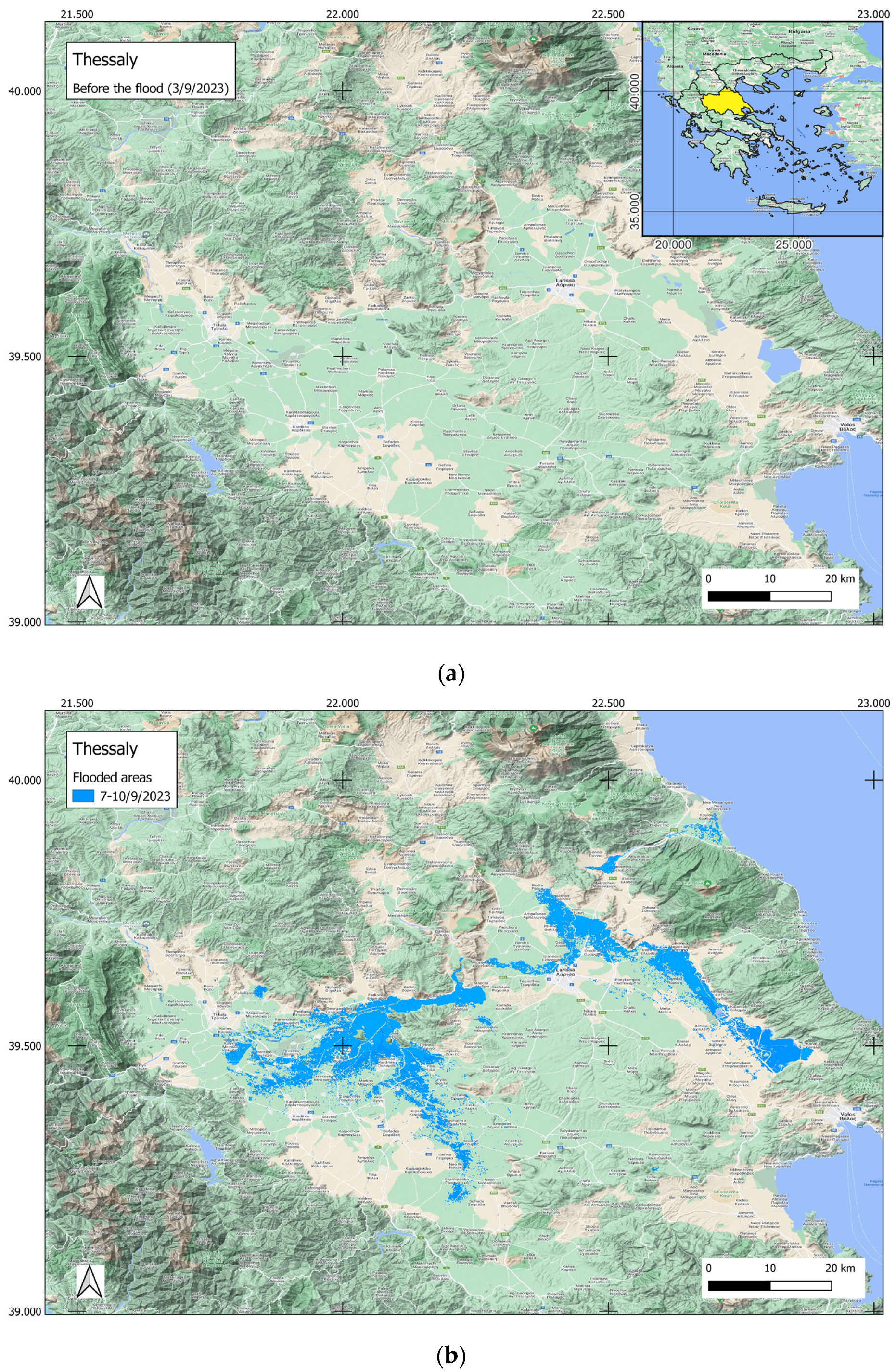
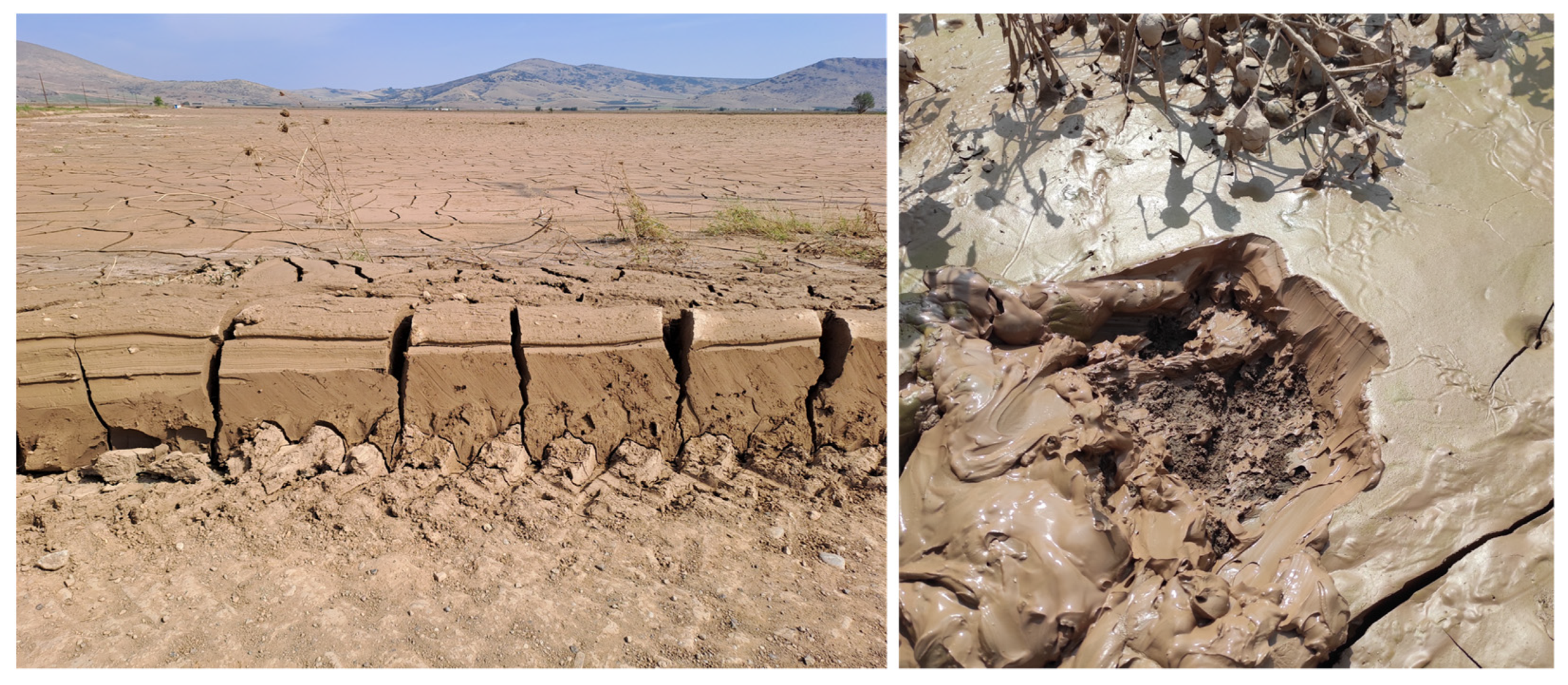
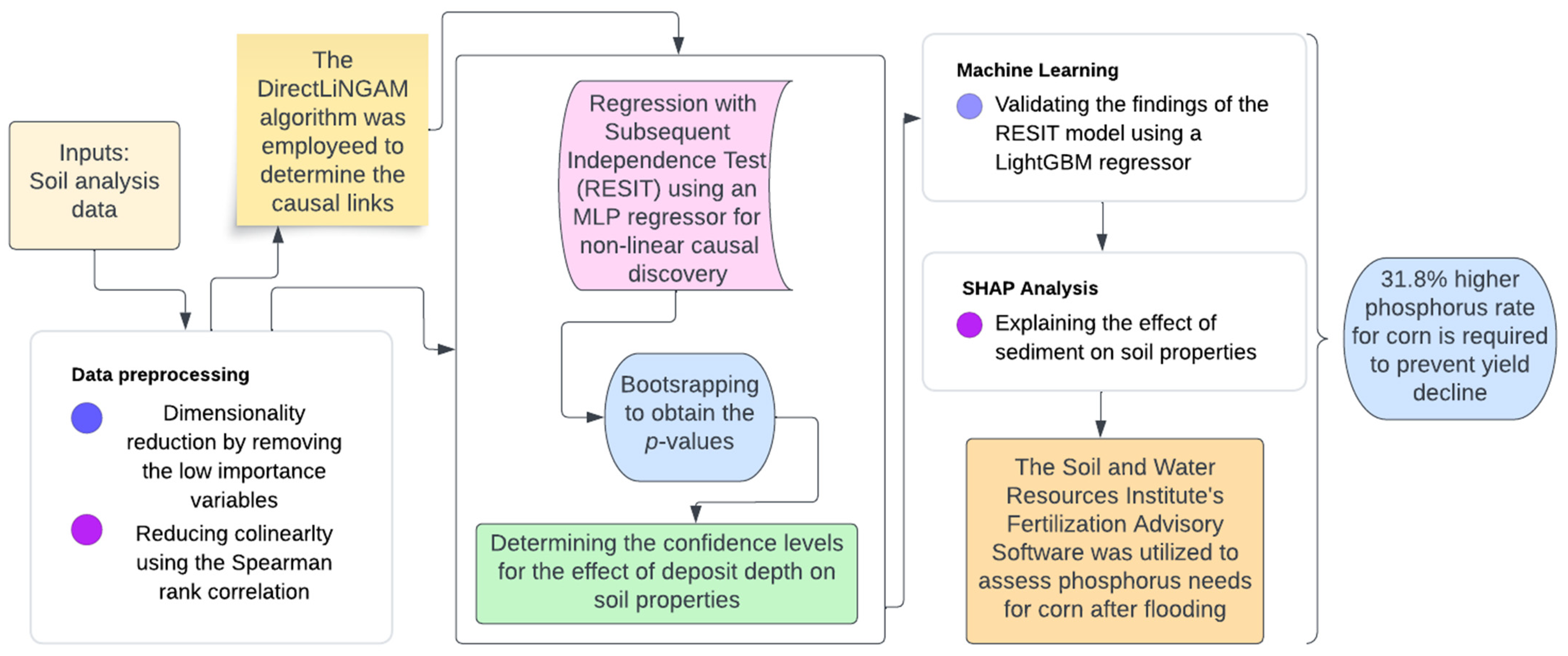
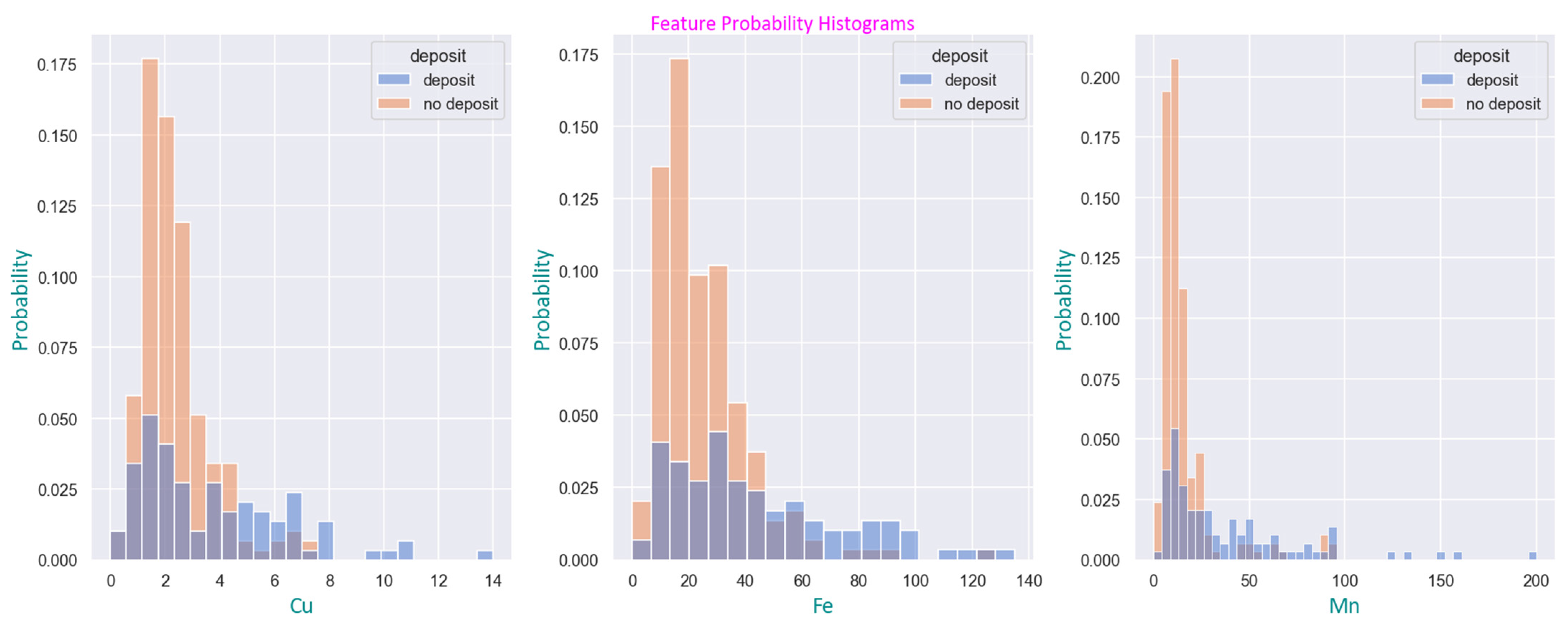

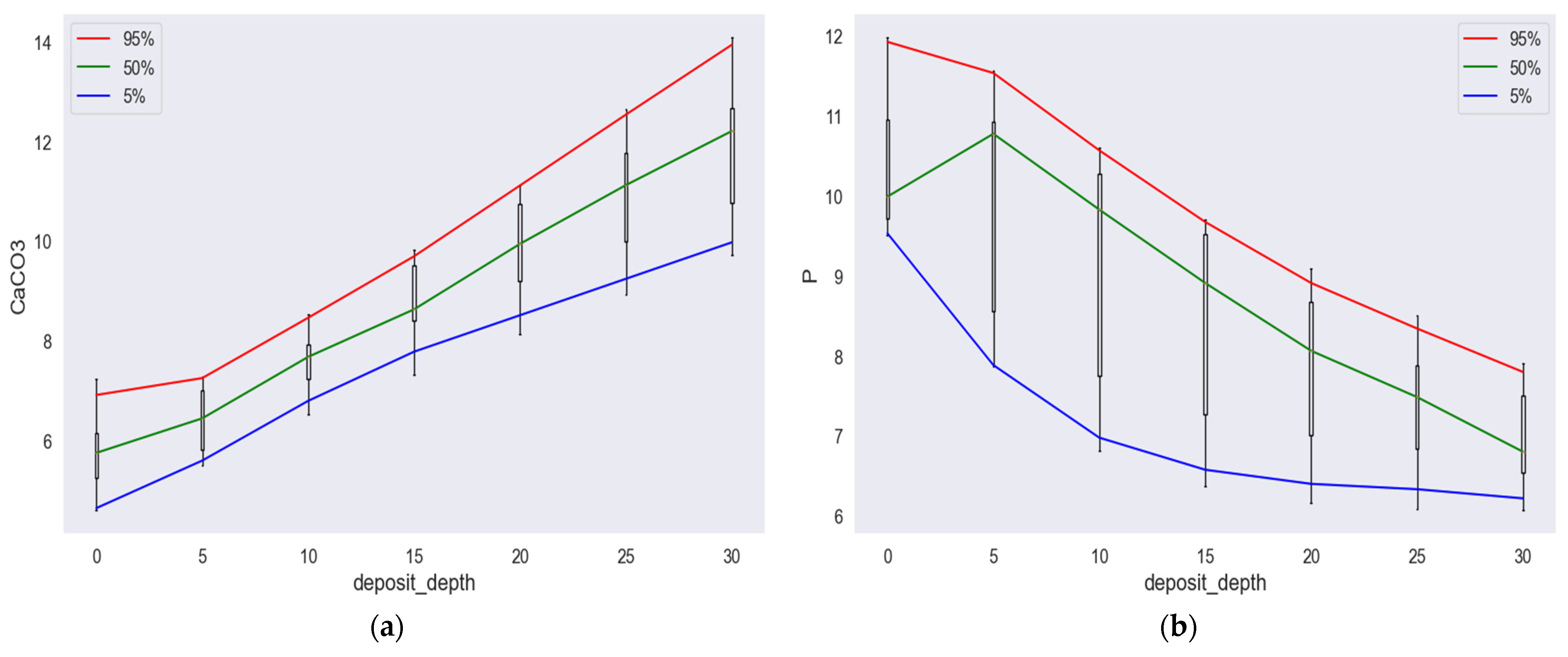

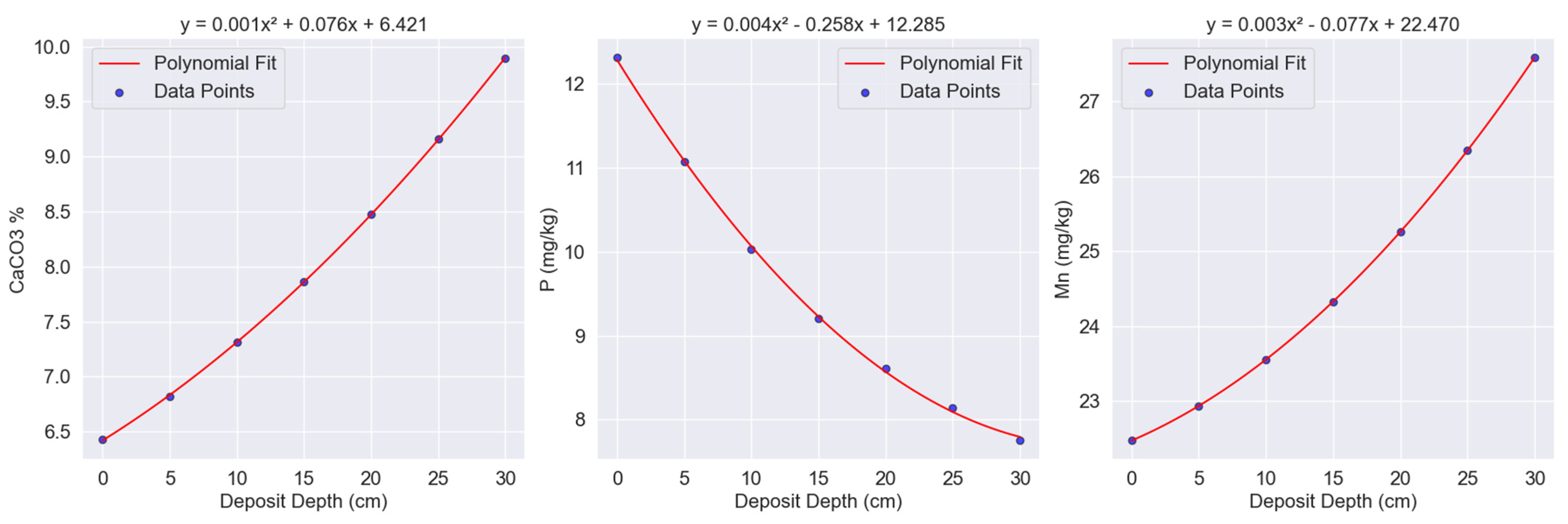
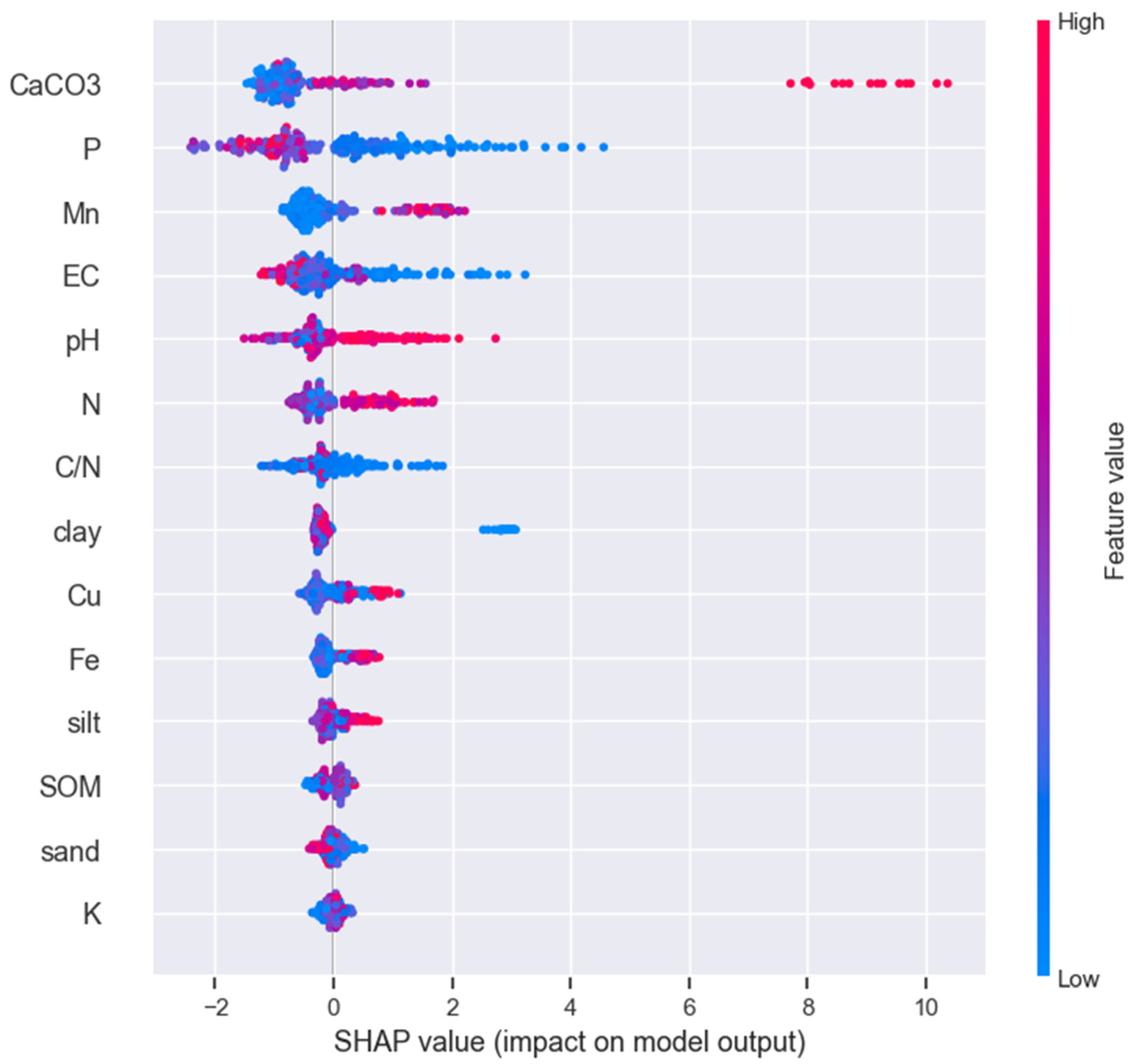
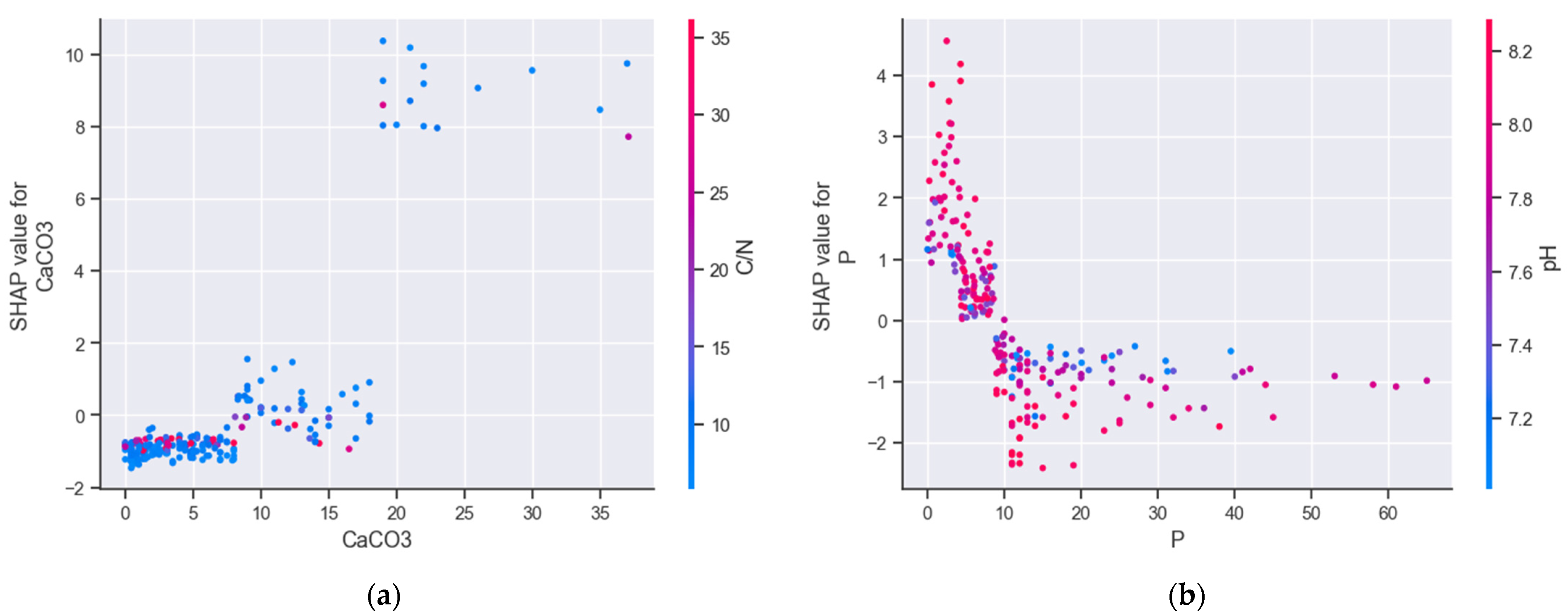
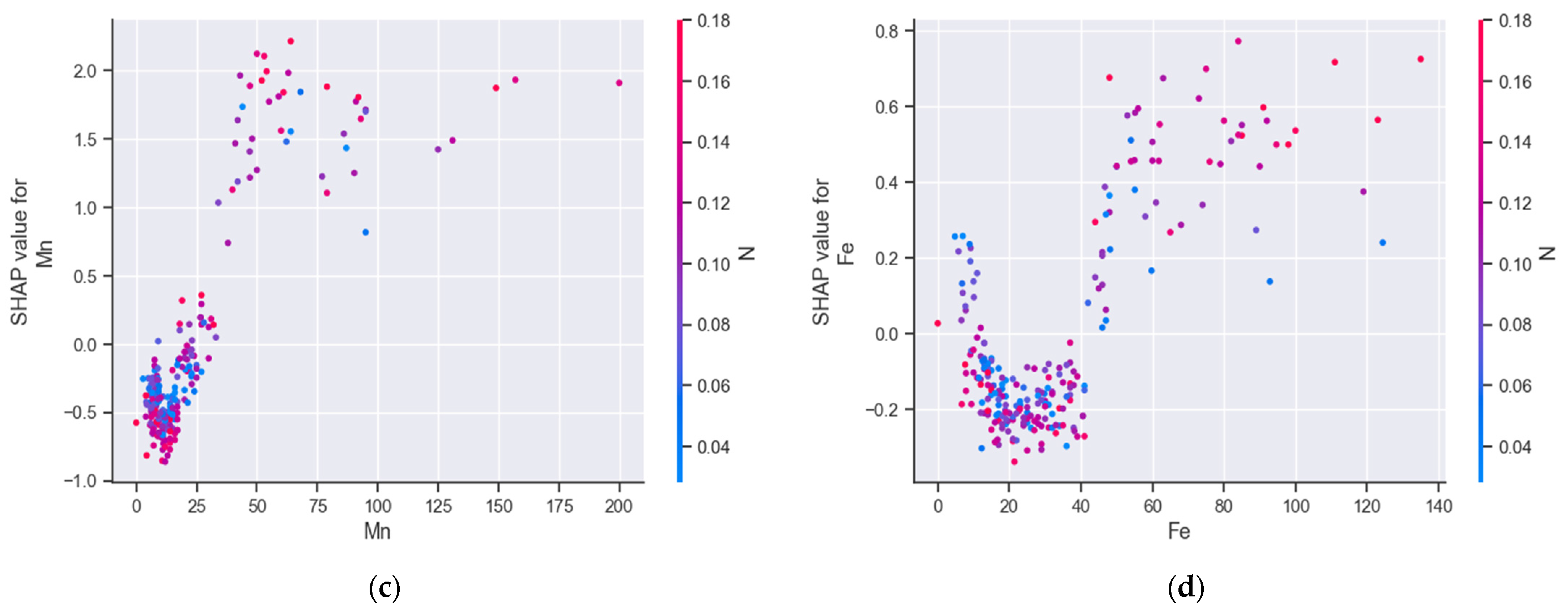
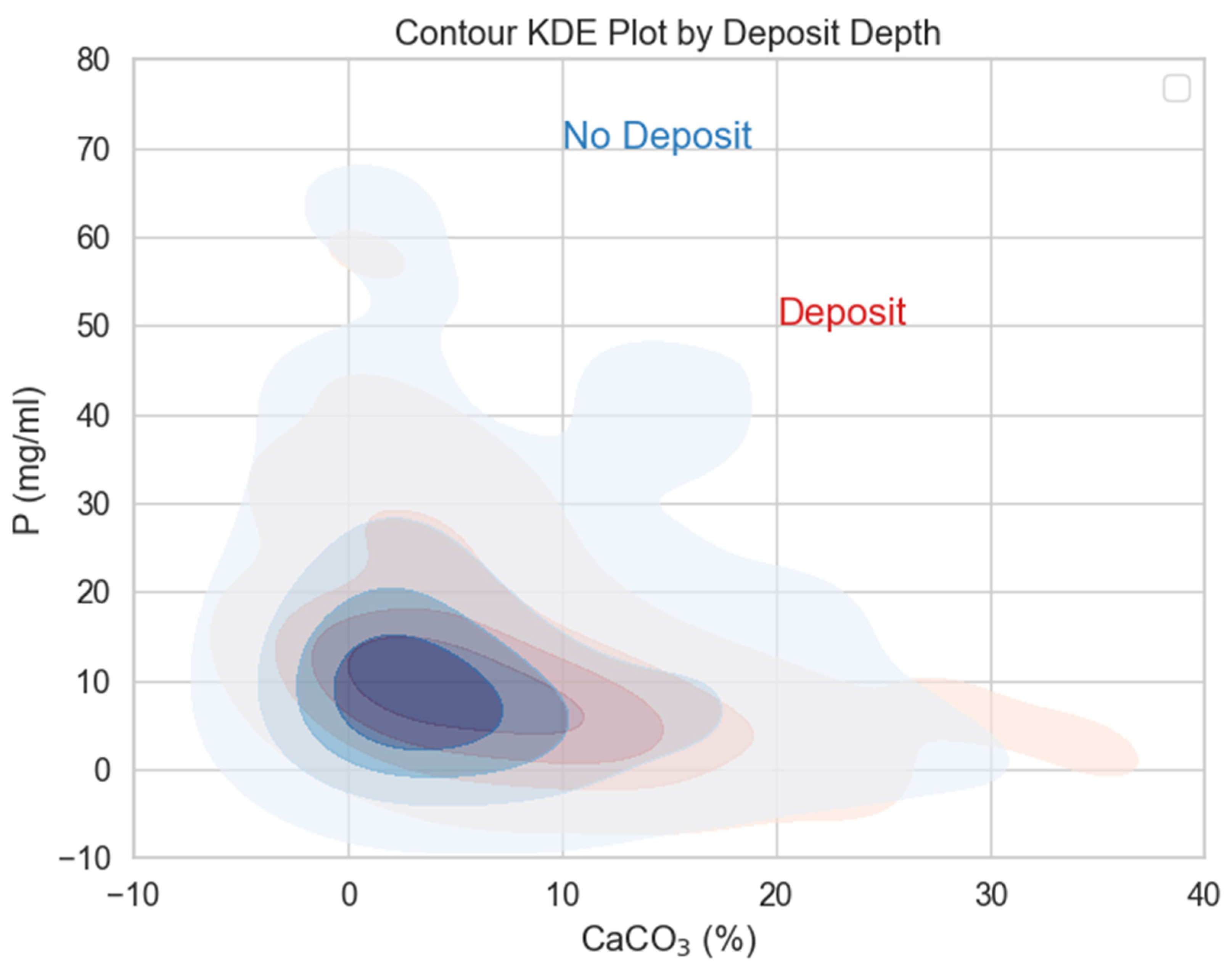

| Soil Variables | Definition | Mean | Std * |
|---|---|---|---|
| Clay | Weight percentage of clay | 26.56% | 14.00 |
| Sand | Weight percentage of sand | 38.99% | 13.09 |
| Silt | Weight percentage of silt | 34.41% | 10.64 |
| pH | Soil pH in soil to water ratio 1:1 | 7.82 | 0.43 |
| EC | Electrical conductivity in soil to water ratio 1:1 | 480.14 μS/cm | 318.82 |
| CaCO3 | Calcium carbonate content | 6.8% | 7.28 |
| SOM | Soil organic matter content | 1.71% | 0.63 |
| N | Total Kjeldahl soil nitrogen | 0.1% | 0.05 |
| C/N | Ratio of organic carbon to nitrogen | 12.94 | 10.72 |
| P | Olsen extractable phosphorus | 11.78 mg/kg | 10.74 |
| K | Ammonium acetate extractable potassium | 0.6 cmol/g | 0.37 |
| Cu | DTPA extractable copper | 2.83 mg/kg | 2.00 |
| Fe | DTPA extractable iron | 31.19 mg/kg | 23.64 |
| Mn | DTPA extractable manganese | 23.08 mg/kg | 27.02 |
Disclaimer/Publisher’s Note: The statements, opinions and data contained in all publications are solely those of the individual author(s) and contributor(s) and not of MDPI and/or the editor(s). MDPI and/or the editor(s) disclaim responsibility for any injury to people or property resulting from any ideas, methods, instructions or products referred to in the content. |
© 2024 by the authors. Licensee MDPI, Basel, Switzerland. This article is an open access article distributed under the terms and conditions of the Creative Commons Attribution (CC BY) license (https://creativecommons.org/licenses/by/4.0/).
Share and Cite
Iatrou, M.; Tziouvalekas, M.; Tsitouras, A.; Evangelou, E.; Noulas, C.; Vlachostergios, D.; Aschonitis, V.; Arampatzis, G.; Metaxa, I.; Karydas, C.; et al. Analyzing the Impact of Storm ‘Daniel’ and Subsequent Flooding on Thessaly’s Soil Chemistry through Causal Inference. Agriculture 2024, 14, 549. https://doi.org/10.3390/agriculture14040549
Iatrou M, Tziouvalekas M, Tsitouras A, Evangelou E, Noulas C, Vlachostergios D, Aschonitis V, Arampatzis G, Metaxa I, Karydas C, et al. Analyzing the Impact of Storm ‘Daniel’ and Subsequent Flooding on Thessaly’s Soil Chemistry through Causal Inference. Agriculture. 2024; 14(4):549. https://doi.org/10.3390/agriculture14040549
Chicago/Turabian StyleIatrou, Miltiadis, Miltiadis Tziouvalekas, Alexandros Tsitouras, Elefterios Evangelou, Christos Noulas, Dimitrios Vlachostergios, Vassilis Aschonitis, George Arampatzis, Irene Metaxa, Christos Karydas, and et al. 2024. "Analyzing the Impact of Storm ‘Daniel’ and Subsequent Flooding on Thessaly’s Soil Chemistry through Causal Inference" Agriculture 14, no. 4: 549. https://doi.org/10.3390/agriculture14040549
APA StyleIatrou, M., Tziouvalekas, M., Tsitouras, A., Evangelou, E., Noulas, C., Vlachostergios, D., Aschonitis, V., Arampatzis, G., Metaxa, I., Karydas, C., & Tziachris, P. (2024). Analyzing the Impact of Storm ‘Daniel’ and Subsequent Flooding on Thessaly’s Soil Chemistry through Causal Inference. Agriculture, 14(4), 549. https://doi.org/10.3390/agriculture14040549











